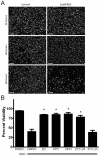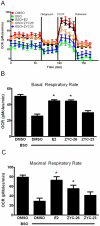Estrogen prevents oxidative damage to the mitochondria in Friedreich's ataxia skin fibroblasts
- PMID: 22509330
- PMCID: PMC3318005
- DOI: 10.1371/journal.pone.0034600
Estrogen prevents oxidative damage to the mitochondria in Friedreich's ataxia skin fibroblasts
Abstract
Estrogen and estrogen-related compounds have been shown to have very potent cytoprotective properties in a wide range of disease models, including an in vitro model of Friedreich's ataxia (FRDA). This study describes a potential estrogen receptor (ER)-independent mechanism by which estrogens act to protect human FRDA skin fibroblasts from a BSO-induced oxidative insult resulting from inhibition of de novo glutathione (GSH) synthesis. We demonstrate that phenolic estrogens, independent of any known ER, are able to prevent lipid peroxidation and mitochondrial membrane potential (ΔΨm) collapse, maintain ATP at near control levels, increase oxidative phosphorylation and maintain activity of aconitase. Estrogens did not, however, prevent BSO from depleting GSH or induce an increased expression level of GSH. The cytoprotective effects of estrogen appear to be due to a direct overall reduction in oxidative damage to the mitochondria, enabling the FRDA fibroblast mitochondria to generate sufficient ATP for energy requirements and better survive oxidative stress. These data support the hypothesis that phenol ring containing estrogens are possible candidate drugs for the delay and/or prevention of FRDA symptoms.
Conflict of interest statement
Figures









References
-
- Friedreich N. Uber degenerative Atrophie der spinalen Hinterstrange. Arch Pathol Anat Phys Klin Med. 1863;26:391–419.
-
- Friedreich N. Uber degenerative Atrophie der spinalen Hinterstrange. Arch Pathol Anat Phys Klin Med. 1863;26:433–459.
-
- Friedreich N. Uber degenerative Atrophie der spinalen Hinterstrange. Arch Pathol Anat Phys Klin Med. 1863;27:1–26.
-
- Harding AE. Classification of the hereditary ataxias and paraplegias. Lancet. 1983;1:1151–1155. - PubMed
Publication types
MeSH terms
Substances
Grants and funding
LinkOut - more resources
Full Text Sources
Other Literature Sources
Medical
Research Materials

